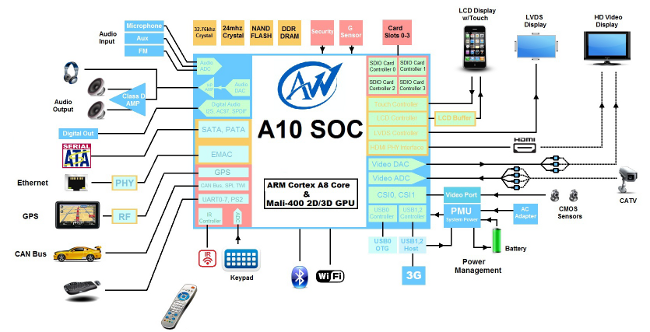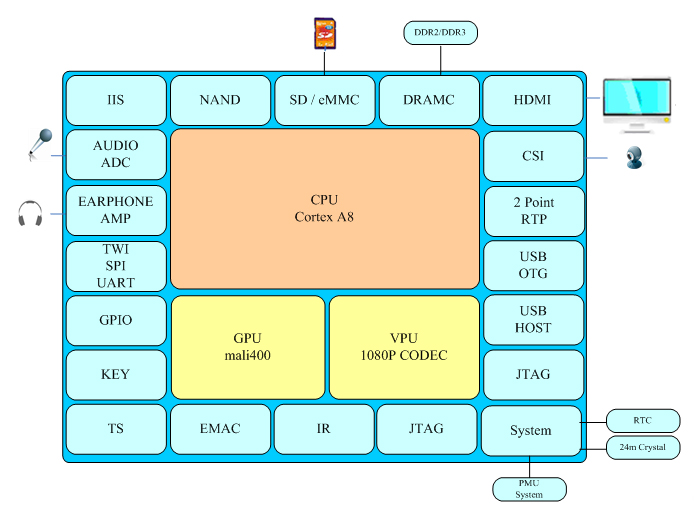The International ARM Race: Rise Of The Chinese SoC
Thanks to low prices and a gradual increase in both quality and performance, Chinese chip makers are starting to pose serious problems for Qualcomm, Nvidia and others.
Allwinner
Allwinner Technology is a China-based fabless semiconductor company founded in 2007. It was one of the first few independent companies to become an ARM licensee, and is probably the first Chinese SoC manufacturer to get our attention in the U.S. with its Android-oriented platforms. Its single-core A10 (Cortex-A8 with Mali 400 GPU), released in late 2010, proved that a Chinese processor could compete with more heavily-marketed brands. Even still, its focus has been largely on mid- and low-end budget tablets, PMPs. and HDMI media sticks, and not so much on smartphones.
The A10 was so prolific that it distorted prices in the Chinese tablet market for almost a year. Its combination of a modest ARMv7 CPU and a then-leading-edge Mali 400 GPU meant that even though it employed one core, it could match the gaming performance of Nvidia’s substantially more expensive Tegra 2. Indeed, such excitement grew around the Mali GPU that a GPU emulation layer, called Chainfire 3D (no longer in development), gained a lot of support from customers with A10-equipped devices.
Back then, forums were filled with reports of A10-based tablets running quite a few high-end Tegra 2-optimized games smoothly and, in some cases, with more features enabled (such as FSAA) than what was thought to be theoretically possible at the time on Nvidia’s GeForce ULP GPU.
Allwinner is again focusing on premium GPU performance with its quad-core A31, based on Cortex-A7 and equipped with the PowerVR SGX 544 GPU. This is the same GPU that was used in the third-gen iPad, thus enabling a whole swathe of 2048x1536p-class 9- and 10-inch Android tablets at budget prices.
| Soc | CPU Core | GPU Core | Max Resolution | Camera | Video Encode/Decode |
|---|---|---|---|---|---|
| A10 | Cortex A8 (1-core) @ 1.0 GHz | Mali 400 | 1920x1080 | N/A | 1080p @ 30 FPS |
| A10s | Cortex A8 (1-core) @ 1.0 GHz | Mali 400 | 1920x1080 | N/A | 1080p @ 30 FPS |
| A13 | Cortex A8 (1-core) @ 1.0 GHz | Mali 400 | 1920x1080 | N/A | 1080p @ 30 FPS |
| A20 | Cortex A7 (2-cores) | Mali 400 MP2 | 1920x1080 | 8MP | 1080p @ 30 FPS / 2160p @ 30 FPS |
| A31 | Cortex A7 (4-cores) | PowerVR SGX 544 MP2 | 2048 ×1536 | 12MP | 1080p @ 30 FPS / 4kx2k @ 30 FPS |
| A80 | Cortex A7 (4-cores) / Cortex A15 (4-cores) | PowerVR 6230 | 2560x1600 | 16MP | 4K×2K @ 30 FPS (h.265/VP9 support) |
A10
The A10 SoC has been a major success for Allwinner; it's what put the company on the map as a Chinese mobile chip maker. It was mostly used to drive Android- and Linux-based mini-sticks, but also some sub-$150 tablets like the Ainol Novo 7 Aurora, from India. The processor supports a maximum resolution of 1920x1080, though it’s mostly often seen in tablets with 1024x600 or 1280x800 resolutions.
A10s
The A10s is basically a stripped-down A10 that’s less expensive. Allwinner uses the A10s to target cheap mini TV sticks. It also adds DLNA and Wi-Fi display support. Compared to the A10, you get better power management, too.
A13
Allwinner’s A13 is one of the company's more recently released chips, and is targeted mainly at small tablets and e-readers. However, even though it's new, the processor only comes with a Cortex-A8 CPU and Mali-400 MP1 GPU. This isn’t one of Allwinner's more powerful offerings.
Get Tom's Hardware's best news and in-depth reviews, straight to your inbox.
A20
The A20 followed the A10, doubling CPU and GPU core count, while switching to Cortex-A7 from -A8 for better battery life and adding support for cameras. Cleverly, it was pin-compatible with the A10, theoretically meaning that tablet manufacturers could just use it in place of its predecessor to save design time. In practice, though, the market had already started shifting to quad-core platforms, so the A20 saw mixed success.
A31
The A31 seems to be recreating the A10 budget hero experience. Just as that old classic introduced 720/800p tablets to the market at affordable prices, the A31 seems to be doing the same for Retina-class resolutions in the 9.7-inch range. The -A7 CPU aspect of the chipset isn't particularly powerful, but it is extremely efficient. On the other hand, the PowerVR 544MP2 GPU is extremely powerful, maxing out many benchmarks. The chipset has also found its way into HDMI sticks. It's currently Allwinner's highest-end SoC, and it also supports camera sensors up to 12 MP.
A80
The Allwinner A80 is expected to arrive this year, at which point it’ll be Allwinner's highest-end chip. It’s too early to tell, but the A80 could put Allwinner in competition with the likes of Samsung, Qualcomm, and Nvidia. The processor will utilize big.Little technology, with quad-core Cortex-A7 and -A15 clusters. The chip is as high-end as you could expect, so it will also have support for 4K video and the hardware-accelerated H.265 and VP9 codecs.
Lucian Armasu is a Contributing Writer for Tom's Hardware US. He covers software news and the issues surrounding privacy and security.
-
jossrik It'll be interesting to see where manufacturing goes in the future, maybe back to EU or even Africa somewhere maybe. Right now it's hard to see things get cheaper than China, but of course, eventually it will happen. I hear Apple is gonna buy China.Reply -
Draven35 ReplyThe company's first commercial foray using this technology came in 1983 with the 16-bit Acorn RISC Machine, or ARM. It ran one of the first true multitasking operating systems in production, RISC OS,
Except, the first silicon didn't exist until 1985, and the machine running RISC OS didn't exist until 1987. -
blubbey ReplyGod bless, America. If you can't beat them, join them!
ARM are British though..... (unless I'm missing something which is entirely possible). -
virtualban The Chinese may leech off and profit from current available designs, and close-source their 'innovations', but I wonder what will they do when the rest of the world will reverse engineer and use any progress they make without having to answer to the Chinese companies (duh).Reply -
icemunk The writer seems to think the RK3288 is a 2015 SOC, however it has been out since April, and many devices are available with it, lots of $200 tablets with 2000X1500 resolution, and a bunch of TV boxes as well for $100. It's an excellent chip, achieving around 40,000 antutu scores. 2015 I'm sure we'll see a brand-new Rockchip, but the RK3288 has been out for some time.Reply -
Reply
MediaTek is Taiwanese not Chinese
remove it from the list
Since when is Taiwanese not Chinese? Read a book. -
oxiide Reply
Hopefully your books mention that the Republic of China (Taiwan) and the People's Republic of China (mainland China) are two distinct and, for the most part, recognized nations.MediaTek is Taiwanese not Chinese
remove it from the list
Since when is Taiwanese not Chinese? Read a book.
MediaTek is indeed a Taiwanese company, though I'd rather they just specify that in the article rather than being told to remove it over a technicality. It's still relevant to the topic regardless of where they are headquartered. -
amk-aka-Phantom Thanks to the author for pointing out the closed-source BS, this makes me hate Mediatek. Others are irrelevant (luckily) so far, don't see their chips in any reasonable devices.Reply





